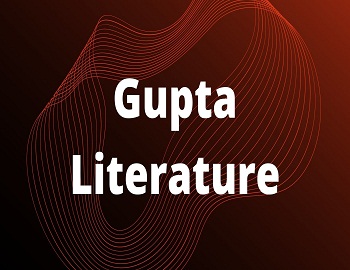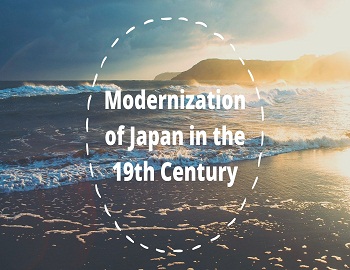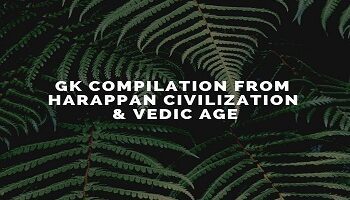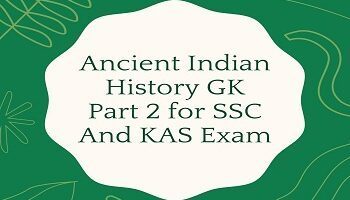Gupta Literature:
The Sanskrit language became prominent during the Gupta period. Nagari script had evolved from the Brahmi script. Numerous works in classical Sanskrit came to be written in the forms of epic, lyrics, drama and prose. The best of the Sanskrit literature belonged to the Gupta age.
Some of the notable Puranas and Smritis were composed or received their final form during the Gupta period. The Smritis of Yajnavalkya, Narada, Katyayana and Brihaspati most probably belong to this period. Yajnavalkya-Smriti may be regarded as the official law book of the Guptas. Civil law and legal procedure were rapidly developing and the works of Narada, Katyayana and Brihaspati are devoted entirely to their discussion. In the field of Arthasastra, it is probable that the Kamandaka Nitisastra was written during this period.
The Puranas were an effective medium of popular instruction, kept up-to-date by constant revision. There are eighteen Puranas. The most important among them are the Bhagavatha, Vishnu, Vayu and Matsya Puranas. The Mahabharatha and the Ramayana were given final touches and written in the present form during this period.
To this period belong thirteen plays written by Bhasa but it is as yet difficult to establish which of these really were written by him. Bhasa made use of the epic tradition, although his plays were constructed strictly according to the laws of classical drama. Some modern scholars maintain and with ample justification that a number of the plays attributed to Bhasa are the most ancient models of Indian tragedy. It was a bold innovation on the part of Bhasa who defied the established artistic canon.
The most outstanding literary figure was Kalidasa who wrote both kavya’s and drama. His masterpiece was the Sanskrit drama Shakuntala. It is considered one among the ‘hundred best books of the world’. He wrote two other plays – the Malavikagnimitra and Vikramorvasiya. His two well-known epics are Raghuvamsa (which refers to the military exploits of Chandragupta II) and Kumarasambhava. Ritusamhara (description of the seasons) and Meghaduta (cloud-messenger) are his two lyrics.
Although somewhat eclipsed by the genius of Kalidasa, there were many other writers of repute during the Gupta period. Sudraka Mrichchakatika (the toy cart of clay) is a superb social drama interspersed with fine humour and deep pathos. Visakadatta’s play Mudrarakshasa dramatised the revolution which placed Chandragupta Maurya on the throne of Magadha. Devichandraguptam, another political drama of Visakadatta, is known from citations in later works. In Kalidasa’s dramas flights of imagination preponderate over realities, while in the plays of Sudraka and Visakadatta, the sense of realism dominates over reason and imagination. Towards the close of the period flourished Bharavi, the author of Kiratarjuniya, an epic poem depicting the Mahabharata story of the combat between Arjuna and god Shiva in the garb of a Kirata. Bharavi’s power of description and dignity of style served as a model for the Sisupalavadha of Magha. While narrating the life of Rama, Bhatti warped the dry rules of grammar with fine literary texture in Ravanavadha, popularly known as Bhattikavya. Bhartihari’s three Satakas– on Niti (ethics), Sringara (love) and Vairagya (renunciation)- are the best specimens of aphoristic literature. Dandin was the author of Kavyadarsa and Dasakumaracharita. Another important work of this period was Vasavadatta written by Subhandhu. The Panchatantra stories were composed by Vishnusarma during the Gupta period. The Buddhist author Amarasimha compiled a lexicon called Amarakosa.
In the field of mathematical and astronomical science, the Gupta Age was adorned by the illustrious names of Aryabhatta and Varahamihira. Aryabhatta, a native of Pataliputra, achieved distinct fame at the age of 23 when he wrote his treatise Aryabhatiyam in 499 A.D. It deals with mathematics and astronomy. It explains scientifically the occurrence of solar and lunar eclipses. Aryabhatta was the first to declare that the earth was spherical in shape and that it rotates on its own axis. However, these views were rejected by later astronomers like Varahamihira and Brahmagupta. Varahamihira composed Pancha Siddhantika, the five astronomical systems in 505 A.D. His work Brihajjataka and Laghujataka works on astrology, and Brihat-Samhita a cyclopaedia of technical sciences like astrology, geography, architecture, physiognomy, metallurgy and so on. Brahmagupta, another famous astronomer and mathematician of the age, anticipated Newton by declaring that “all things fall to the earth by the law of nature; for it is the nature of the earth to attract and keep things”.
The discovery of ancient texts dealing with medicine, popularly known as the Bower manuscript, in Kashgar in 1890, proves that Indians showed keen interest in medical science as well. The Ashtangasamgraha (Summary of the eight branches of medicine) by Vagbhata I, a systematic summary of Charaka and Susruta, the Navanitakam, an anonymous manual of recipes, formulas and prescriptions and Hastyayurveda of Palakapya, a treatise on the diseases of elephants, their diagnosis and treatment- show the knowledge of Indians in the diagnostic and curative study of human and animal diseases.
On the whole, basically, the Guptas age was a bright phase in the history of classical literature. There developed an ornate style distinct from the old simple Sanskrit. There began an emphasis on verse than prose.
However, the Gupta literature was mainly for the upper strata of society and in course of time, it lost its natural fluency. It became used for formal mannerisms. Thus, on the one hand, it saw the apex of progress and glory, on the other hand, it set certain precedences that in due course of time made Indian literature colourless.
Nine Gems in the Court of Chandragupta II:
| Name | Field | Contribution |
|---|---|---|
| Harisena | Poetry | Prayag Prashasti |
| Kalidas | Drama and Poetry | Shakuntala, Meghaduta etc. |
| Kshapanaka | Astrology | Jyothisyashastra |
| Dhanvantri | Medicine | Ayurveda (Book of medicine) |
| Amarsimha | Lexicography | Amarakosha |
| Varahamihira | Astrology | Brihat-Samhita |
| Vararuchi | Grammar | Vyakarana (Sanskrit) |
| Sanku | Architecture | Shilpashastra |
| Vetalabhatta | Magic | Mantrashastra |









Comments (No)